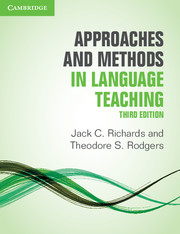Book contents
- Frontmatter
- Contents
- Acknowledgments
- Introduction to the third edition
- I Major trends in twentieth-century language teaching
- II Current approaches and methods
- III Alternative twentieth-century approaches and methods
- IV The teaching and learning environment
- Appendix: Comparison of approaches and methods
- Author index
- Subject index
III - Alternative twentieth-century approaches and methods
Published online by Cambridge University Press: 08 April 2022
- Frontmatter
- Contents
- Acknowledgments
- Introduction to the third edition
- I Major trends in twentieth-century language teaching
- II Current approaches and methods
- III Alternative twentieth-century approaches and methods
- IV The teaching and learning environment
- Appendix: Comparison of approaches and methods
- Author index
- Subject index
Summary
The period from the 1970s to the 1980s witnessed a major paradigm shift in language teaching. The quest for alternatives to grammar-based approaches and methods led in several different directions. Mainstream language teaching embraced the growing interest in communicative approaches to language teaching, as we saw in Part II. The communica-tive movement sought to move the focus away from grammar as the core component of language, to a different view of language, of language learning, of teachers, and of learners, one that focused on language as communication. Other directions in language teaching, also quests for alternatives, appeared during this period and are the focus of this part of the book.
Whereas Audiolingualism and Situational Language Teaching were mainstream teaching methods developed by linguists and applied linguists, the approaches and meth-ods described in this section were either developed outside of mainstream language teach-ing or represent an application in language teaching of educational principles developed elsewhere. They are represented by such innovative methods of the 1970s as the Natural Approach (Chapter 14), Total Physical Response (Chapter 15), the Silent Way (Chapter 16), Community Language Learning (Chapter 17), and Suggestopedia (Chapter 18). Rather than starting from a theory of language and drawing on research and theory in applied lin-guistics, the majority of these methods are developed around particular theories of learn-ers and learning, sometimes the theories of a single theorizer or educator. Many of these methods are consequently relatively underdeveloped in the domain of language theory, and the learning principles they reflect are generally different from theories found in sec-ond language acquisition (SLA) textbooks. The one exception in this group is the Natural Approach, as explained below.
Alternative approaches and methods of the 1970s and 1980s have had a somewhat varied history. Although Total Physical Response, the Silent Way, Community Language Learning, and Suggestopedia did not succeed in attracting the support of mainstream language teaching, each can be seen as expressing important dimensions of the teaching/learning process. They can be seen as offering particular insights that have attracted the attention and/or allegiance of some teachers and educators, but they have each seen their popularity rise and fall since the 1970s.
Information
- Type
- Chapter
- Information
- Approaches and Methods in Language Teaching , pp. 259 - 260Publisher: Cambridge University PressPrint publication year: 2014
